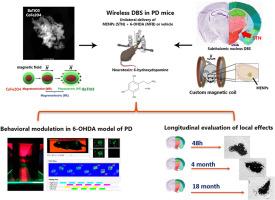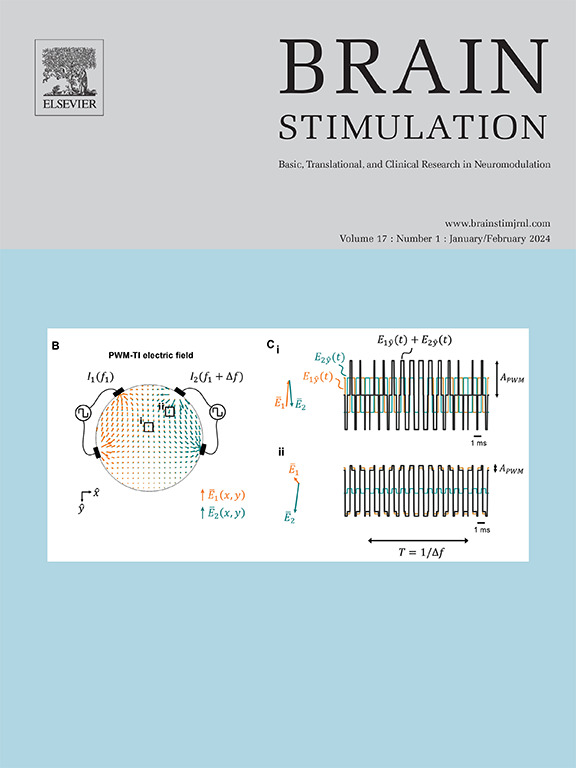Magnetoelectric nanoparticle technology for mitigating motor deficits in Parkinsonian mice
IF 8.4
1区 医学
Q1 CLINICAL NEUROLOGY
引用次数: 0
Abstract
Introduction
Deep brain stimulation (DBS) technology involves wired-in powering of electrodes to modulate deep brain targets in both clinical and preclinical settings. Previously, we demonstrated the feasibility of magnetoelectric nanoparticle (MENP)-based DBS for wireless modulation of the subthalamic nucleus (STh) in mice. However, key aspects such as their ability to alleviate symptoms in disease models, long-term stability and efficacy, as well as optimal magnetic field parameters used to power the particles, remain unaddressed.
Material and method
Herein, for the first time, we applied MENP-based STh-DBS in a Parkinson's disease (PD) model induced by 6-hydroxydopamine (6-OHDA) lesioning to evaluate their potential to alleviate motor deficits. Throughout a parallel study, mice were monitored longitudinally for up to 18 months post injection to assess MENPs retention, efficacy, and long-term local effects.
Results
MENP-based STh-DBS using a field of 140 Hz, 220 mT direct current (DC) and 8 mT of alternating current (AC) was able to improve the locomotion of 6-OHDA treated mice with over 95 % dopaminergic cell loss in the substantia nigra. Postmortem assessment revealed no evidence of sustained or enhanced astro- or microgliosis over 18 months, and no changes in MENP retention or performance.
Conclusion
MENP-based STh-DBS can counteract behavioral disturbances caused by impaired neural circuits following extensive dopaminergic cell loss in PD mice. Additionally, no adverse effects or loss of efficacy were observed over time for up to 18 months with respect to astro- and microgliosis. While effective modulation was only achieved with a higher magnetic coil configuration, this finding represents a critical step toward refining MENP-based neuromodulation in PD.

磁电纳米颗粒技术减轻帕金森小鼠运动缺陷。
简介:脑深部刺激(DBS)技术包括在临床和临床前设置中通过电极的有线供电来调节脑深部目标。在此之前,我们证明了基于磁电纳米粒子(MENP)的DBS对小鼠丘脑下核(STh)无线调制的可行性。然而,诸如减轻疾病模型症状的能力、长期稳定性和有效性,以及用于为颗粒提供动力的最佳磁场参数等关键方面仍未得到解决。材料和方法:本研究首次将menp - STh-DBS应用于6-羟多巴胺(6-OHDA)损伤诱导的PD模型,以评估其缓解运动缺陷的潜力。在一项平行研究中,小鼠在注射后被纵向监测长达18个月,以评估MENPs的保留、疗效和长期局部效应。结果:在140 Hz、220 mT直流和8 mT交流电流的电场下,以menp为基础的STh-DBS能够改善6-OHDA处理小鼠的运动,黑质多巴胺能细胞损失超过95%。尸检评估显示,在18个月的时间里,没有证据显示持续或增强的星形胶质细胞或小胶质细胞增生,MENP保留或表现也没有变化。结论:基于menp的STh-DBS可对抗PD小鼠多巴胺能细胞广泛丧失后神经回路受损引起的行为障碍。此外,在长达18个月的时间里,没有观察到关于星形胶质细胞和小胶质细胞增生的不良反应或疗效丧失。虽然只有在更高的磁线圈配置下才能实现有效的调制,但这一发现代表了完善PD中基于menp的神经调节的关键一步。
本文章由计算机程序翻译,如有差异,请以英文原文为准。
求助全文
约1分钟内获得全文
求助全文
来源期刊

Brain Stimulation
医学-临床神经学
CiteScore
13.10
自引率
9.10%
发文量
256
审稿时长
72 days
期刊介绍:
Brain Stimulation publishes on the entire field of brain stimulation, including noninvasive and invasive techniques and technologies that alter brain function through the use of electrical, magnetic, radiowave, or focally targeted pharmacologic stimulation.
Brain Stimulation aims to be the premier journal for publication of original research in the field of neuromodulation. The journal includes: a) Original articles; b) Short Communications; c) Invited and original reviews; d) Technology and methodological perspectives (reviews of new devices, description of new methods, etc.); and e) Letters to the Editor. Special issues of the journal will be considered based on scientific merit.
 求助内容:
求助内容: 应助结果提醒方式:
应助结果提醒方式:


